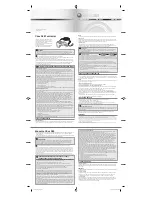
< 2. Installing FA-M3 Programming Tool WideField2 (SF620-ECW)>
2-1
TI 34M6A82-01E
2nd Edition : Nov. 1, 2002-00
2. Installing FA-M3 Programming Tool
WideField2 (SF620-ECW)
2.1 Overview of WideField2
The SF620-ECW FA-M3 Programming Tool WideField2 for the
FA-M3 sequence CPU modules allows a user to create and
debug programs, as well as manage applications. Its enhanced
program reuse feature, coupled with functions for debugging
various advanced function modules of FA-M3 dramatically
increases efficiency of program and application development.
Features
Operation
- Screen display and other settings can be restored, removing
the need to re-configure after startup.
- All tag name definition data can be edited in a single window.
- Menus support shortcut keys.
- All instructions and line connections can be entered using
the keyboard or function keys.
- A user can search an entire project and then jump from the
search results window directly to the appropriate location in
a program edit or monitor window.
- Circuits can be copied and pasted between programs.
- Address and I/O comments can be entered concurrently with
instruction parameters.
- I/O comments can be searched when editing tag name
definitions. Search and replacement functions permit the use
of the wildcard character.
Program Reuse
- Supports modular programming using function blocks.
- Frequently used circuits can be registered as macros and
shared with other developers in a library.
- Macros can be used as input conditions.
- Local devices can be used in blocks and component macros.
Blocks coded using local devices can be reused in other
projects without modifications.
- Structure data format is supported. Structure data can also
be used to interface with macros and be used in arrays.
- Both index modification by constant or indirect designation
are supported.
- Supports program design by tag names. Programs can be
created before terminals are allocated. Up to 70,000 tag
names and I/O comments in multiple blocks and component
macros can be collectively managed.
- Individual
blocks can be configured to refer to block tag
name definitions, instead of common tag name definitions.
- All tag names used in circuits can be collectively read; all tag
names not used in circuits can be collectively deleted.
- Changes in installed positions of I/O modules can be
implemented over all blocks of a project with a single
operation.
- Projects can be saved with a new name.
- WideField2 is downward compatible with WideField (SF610).
- Programs in CADM3 (SF510) format can be opened.
Data Exchange with Other Applications
- Circuits can be pasted to other applications.
- Tag names and I/O comments can be copied and pasted
between Microsoft Excel and WideField2.
- Results of sampling trace can be generated in Microsoft
Excel format for conversion to graphs.
- Device data edited in WideField2 can be exported in
Microsoft Excel format.
Operating Environment
Item Specification
PC PC/AT
Compatible
OS
Microsoft Windows 2000
Microsoft Windows NT Workstation 4.0,
Service Pack 3 and above
Microsoft Windows Me
Microsoft Windows 98
Microsoft Windows 95 OSR2
Microsoft Windows XP
Required
Software
Internet Explorer 4, SP2 and above
Media CD-ROM
CPU Pentium133MHz
min.
(when using RS-232-C communications
with Ethernet)
Memory
32 MB min.
(when using RS-232-C communications
with Ethernet)
Hard Disk
Capacity
200MB min.
Display 800
×
600 dots or higher resolution
Communicati
ons
RS-232-C
,
Ethernet
Printer
A printer that supports A4 size paper and
the above operating systems.
Japanese
FEP
MS-IME and others
CPU
Module
F3SP05-0P, F3SP08-0P,
F3SP21-0N, F3SP25-2N, F3SP35-5N,
F3SP28-3N, F3SP38-6N, F3SP53-4H,
F3SP58-6H, F3SP28-3S, F3SP38-6S,
F3SP53-4S, F3SP58-6S, F3SP59-7S,
F3SPV3-4H, F3SPV8-6H, F3FP36-3N
Model and Suffix Codes
Model
Suffix
Code
Style
Code
Option
Code
Description
• • • • • •
• • • • • •
• • • • • •
FA-M3 Programming
Tool WideField2
SF620
-ECW
English
version
















































